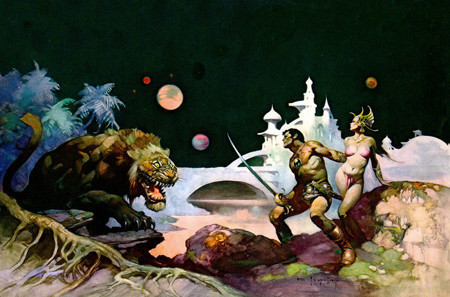In the 1960s, children of my generation rediscovered pulp fiction through the mass-market editions of Tarzan and John Carter of Mars, both written by Edgar Rice Burroughs. As an adult, while researching a book on pulp magazines, I reread Burroughs' work for the first time in decades and I was happy to learn that his work, like that of many of his contemporaries who wrote pulps, is just as inventive, energetic, and fun as the first time I experienced it. It's little wonder that mainstream culture has been so influenced by this kind of story-telling.

An illustrated scene from John Carter of Mars.
Everything in entertainment today -- from the new hit video game "L.A. Noire" and the world created by James Cameron in his blockbuster "Avatar" to upcoming films like next spring's "John Carter" -- bears the stamp of the pulps. Modern popular culture, especially film culture, is, in many ways, pulp culture.
Indeed, you already know the pulp aesthetic, even if not by name. It focuses on series characters whose situations never change; the use and exploitation of the exotic, whether racial, sexual, socioeconomic, or geographic; simple emotions strongly expressed; and, always, happy endings and good winning over evil. Sounds a lot like the Hollywood we know and love today, doesn't it?
Hollywood's favorite formula was first tested in comics and radio. With the rise in radio in the 1920s and the rise in comic books in the late 1930s, the number of stories influenced by the pulps skyrocketed and serialized, hero-centered plots became the standard for genre story-telling.
The surge was further fueled by a wave of new and very popular characters pulled from the pulps. Such heroes included Dr. Kildare, the Three Mesquiteers, and Stuart Webbs, among dozens of others. The majority of these new movie franchises were based on pre-existing characters and success wasn't just limited to the most popular ones. Even obscure print characters, like Frank Spearman's railroad detective Whispering Smith, inspired and carried movie franchises.
And then, of course, there was Edgar Rice Burroughs. In 1912 Burroughs' A Princess of Mars (the first John Carter novel) and Tarzan of the Apes (the first Tarzan novel) were both published as pulp serials, and then as novels. Burroughs was not the first to write a Planetary Romance story, nor the first to pen a Lost Race/man-raised-by-animals tale. Burroughs was not even the first to find success in writing popular examples of both.

Edgar Rice Burroughs.
What set Burroughs apart was the scale of his success and the influence his work had on everyone who followed. Burroughs may not have invented ray guns, aliens employing human feudalism, humans being raised by impossibly intelligent and communicative animals, nor any of the other tropes and motifs -- now sci-fi clichés -- but he popularized them so successfully that his approach became not just the standard, but the archetypal approach for all sci-fi writers and directors since. Burroughs' approach to his stories -- efficient narration, constant forward momentum, and the story-as-pure-expression-of-id that critic John Clute called the "literalization of the dream" -- defines entertainment today. He catered to the readers' pleasure principle, a state of affairs recognizable to any modern movie-goer.
Pulp-influenced films went in decline for a few decades before 1977, but then Hollywood saw the colossal success of "Star Wars" and the face of modern cinema forever changed. "Star Wars" is rightfully credited with having created the modern blockbuster, but it was also an embodiment of the pulp aesthetic. If, as is often said, "Star Wars" turned film away from the emphasis on character and theme toward the more adventurous and special effects-laden story arc -- a change felt in fiction, television, comics, and video games -- then it can also be said that "Star Wars" brought the pulp aesthetic back into the mainstream and made it more popular and more influential than ever.
Today, film and video games are the most culturally dominant story-telling forms, and both increasingly rely on comics and the pulps as the source of ideas and concepts. As evidence of this, Marvel Comics has partnered with Disney and DC Comics with Warner Brothers to deliver the pulp promise to an eager, worldwide film audience. The increasing emphasis and reliance on franchises and sequels, comic characters as the source of those franchises, the use of special effects, stunts, and action scenes -- all spring from the pulps and demonstrate the enduring influence of Edgar Rice Burroughs.
Burroughs' dreamscapes have become our dreamscapes.
For the most up-to-date information about JOHN CARTER, visit Facebook.com/JohnCarterMovie